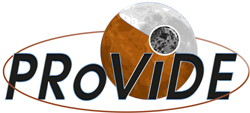Rover traverse data, along with various topographic mapping products, have been extensively used to support scientific investigations and mission operations [103]-[109]. For example, rover localization data were critical in the planning and analysis of coordinated experiments between the Spirit rover and the MGS (Mars Global Surveyor), ODY (Mars Odyssey), MRO (Mars Reconnaissance Orbiter), and MEx (Mars Express) orbiters, and enabled in situ rover observations to be “ground truth” for the calibration of a variety of orbital remote sensing data [110]-[113]. Rover traverse data have also been essential in analyzing the abundance of rocks, craters and hollows in the plains of Gusev crater [114]-[116] as well as providing the topographic profiles needed to infer possible water pathways and to study aqueous processes at Gusev crater [117]-[118]. In addition, rover traverse data and 3D mapping products have been used extensively in crater gradation analysis for both the Gusev crater and Meridiani Planum landing site, revealing for example that impact craters at Gusev crater are due mostly to secondary impacts while at Meridiani Planum they are due mostly to primary impacts and that all of the impact craters have been modified primarily by eolian erosion and infilling [119]. Furthermore, localization data and slope maps were used directly in determination of potential locations on the north side of Home Plate to tilt the rover to maximize incident sunlight on the solar panels during several Martian winters, thus ensuring the survival of Spirit. Similar analyses are ongoing right now with the still-operating opportunity rover in Meridiani, which is facing similar low winter insolation issues.
High precision localization of each rover and registration of each rover’s traverse onto HiRISE (High Resolution Image Science Experiment) base maps has been fundamentally important for geological mapping at both sites through comparison and integration of rover and HiRISE (High Resolution Image Science Experiment) observations [120]-[123]. For example, the fading (dust-covered) rover tracks were used to study the aeolian dynamics in the area from the Winter Haven on the northern edge of Home Plate to the side of Scamander crater [124]-[125]. With the help of rover localization data, the morphology and texture of hundreds of loose surface rocks, pebbles, and cobbles along the Spirit rover traverse from Sol 750 to Sol 1890 were studied to assess origin, transport, and association with geologic units as well as alteration mechanisms that acted upon these particles during and after formation [126]. It was found that the characteristics of these regolith particles within the Home Plate region are comparable to those of particles imaged prior to arrival at Home Plate, indicating that no appreciable transport has occurred subsequent to fragmentation from outcrop and emplacement [126]. Rover localization data were also used to find the distribution of stony meteorite candidate rocks at Meridiani Planum; based on rover localization results it has been suggested that these meteorites are fragments of a strewn field that was created from the breakup of a larger body [127].
From an operational perspective, rover localization and topographic products have also been critical for placement of in situ chemical and mineral analysis instruments as well as the rover’s brushing/drilling tool. The ability to rapidly create 3D visualisations and miniature “terrain models” for rocks or sand dunes, etc. has proven to be essential for minimizing the amount of time it takes to accurately place instruments onto specific targets, as well as to ensure that there are no hazards in the rover work volume which could impact (quite literally) the rover’s arm or instrument deployments.
The PRoViDE (Planetary Robotics Vision Data Exploitation) added-value mechanisms such as BRDF (Bi-directional Reflectance Distribution Functions) and shape-from-shading allow reflectance spectra and 3D models of science targets to be generated for those situations where multi-spectral image data has only been captured using a single camera. This applies to both planetary surface and orbital image data [128]. The proposed 3D visualisation and rendering tool provides the planetary scientist with the ability to explore the lunar and Mars surfaces multi-dimensionally, for example, by using false-colour coded reflectance data overlaid onto the 3D terrain surface. Alternatively the planetary scientist is able to explore 3D lunar and planetary surfaces and select ROI (regions of interest) to reveal key associated science data such as the illumination spectral power distribution and ROI (regions of interest) target reflectance spectrum.
These are just a few of the kinds of science assessment/analysis examples that are enabled by high-quality stereo imaging and terrain mapping using surface assets like rovers. Similar kinds of geologic, topographic, and scientific assessment capabilities are required for future landers and rovers sent to Mars, as well as those sent to the Moon, asteroids, and other planetary surfaces. Thus, the procedures and products generated and disseminated here are likely to have wide applicability across many planetary exploration subdisciplines.
In complement, orbital DTM (Digital Terrain Model) information is vital for rover operations, especially related to rover hibernation during the harsh Mars winter as well as long-range target selection beyond the rover’s very limited local horizon. Increasingly orbital hyperspectral imagery from CRISM (Compact Reconnaissance Imaging Sepctrometer for Mars) (at resolutions up to 30m) is being exploited to select these long-range targets such as the recent discovery of phyllosilicate clays at the Endurance crater for the MER (Mars Exploration Rover) Opportunity rover [129].


